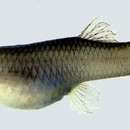Lifespan, longevity, and ageing
provided by AnAge articles
Maximum longevity: 3 years
Observations: The majority of animals die in the first year of life. Although age at sexual maturity has not been determined, it is likely less than three months. Reproductive senescence has been documented in these animals (Patnaik et al. 1994).
- license
- cc-by-3.0
- copyright
- Joao Pedro de Magalhaes
- editor
- de Magalhaes, J. P.
Brief Summary
provided by EOL authors
The mosquitofish (
Gambusia affinis) is a species of freshwater fish in the family Poeciliidae, native to the Mississippi River (USA) and its tributary waters from southern Indiana and Illinois to the Gulf Coast and parts of northeastern Mexico. It is commonly known by its generic name, gambusia, and sometimes called the western mosquitofish to distinguish it from the closely related eastern mosquitofish (
G. holbrooki), which according to ITIS is actually a subspecies of
G. affinis, rather than its own species; this has complicated classification of
G. affinis). The name "mosquitofish" was given because the diet of this fish predominantly consists of large amounts of mosquito larvae (as well as other invertebrate larvae); an adult female can consume hundreds in a day. Hardy to a variety of temperatures, salinities and oxygen levels, mosquitofish have spread through many parts of the world in introductions attempting to reduce mosquito populations. Although this biocontrol did play a major role in containing malaria in South America, Russia and the Ukraine in the 1920s, they are now recognized the Global Invasive Species Database as one of the world’s 100 worst invasive species. This voracious, aggressive predator has extirpated and eliminated many native species, is extremely hard to eradicate, and is now a pest in fresh and brackish waters around the world. Mosquitofish are small; females reach an overall length of 7 centimeters and males at a length of 4 centimeters (1.6 in). Like all other New World members of this family,
G. affinis gives birth to live young. (
Froese and Pauly 2011;
ITIS 2011;
IUCN/SSC Invasive Species Specialist Group 2010;
Wikipedia 2012)
Diseases and Parasites
provided by Fishbase
Rhabdochona Infestation 6. Parasitic infestations (protozoa, worms, etc.)
Trophic Strategy
provided by Fishbase
Inhabits standing to slow-flowing water; most common in vegetated ponds and lakes, backwaters and quiet pools of streams (Ref. 5723). Most abundant in lower reaches of streams (Ref. 44091). Frequents brackish water. Feeds on insects, zooplankton and detritus. Used as live food for carnivorous aquarium fishes (Ref. 5723).
Morphology
provided by Fishbase
Dorsal spines (total): 0; Dorsal soft rays (total): 7 - 9; Analspines: 0; Analsoft rays: 9 - 10
Migration
provided by Fishbase
Potamodromous. Migrating within streams, migratory in rivers, e.g. Saliminus, Moxostoma, Labeo. Migrations should be cyclical and predictable and cover more than 100 km.
Life Cycle
provided by Fishbase
The species is viviparous (Ref. 5258). Internal fertilization is possible because the anal fin of the male is modified into a copulatory organ. The females carries about 30 alevins and gestation lasts for a period of 24 days (Ref. 6348) to a month (Ref. 30578).
Diagnostic Description
provided by Fishbase
Origin of dorsal fin opposite 7th anal ray. Length of anal base much less than half distance from caudal. 8 horizontal scale rows between back and abdomen. Ventrals terminate immediately before anal fin. Pelvic fins reach ventrals.
Biology
provided by Fishbase
Most abundant in lower reaches of streams (Ref. 44091). Adults inhabit standing to slow-flowing water; most common in vegetated ponds and lakes, backwaters and quiet pools of streams. Found frequently in brackish water (Ref. 5258). Pelagic and surface predatory fish (Ref. 94816). Feed on zooplankton, small insects and detritus (Ref. 5258, 10294). Used as live food for carnivorous aquarium fishes. Viviparous (Ref. 5258, 30578). Effective in mosquito control and widely introduced, but found to compete with indigenous fish and to upset the ecological balance (Ref. 6351).
Importance
provided by Fishbase
fisheries: minor commercial; aquarium: commercial
分布
provided by The Fish Database of Taiwan
原產於北美洲及中美洲的淡水系,約於1913年引入臺灣。現已普遍存在於各溪流、湖沼及田渠等水域。
利用
provided by The Fish Database of Taiwan
為了滅絕蚊子之幼虫而引進之魚種。
描述
provided by The Fish Database of Taiwan
體延長,前部略呈楔狀,後部側扁。雌魚的腹部膨大圓突。頭部中大,吻部短小。眼大,側位;眼間區及吻背略寬而平直。口上位,向後斜下;口裂遠不及眼前緣的下方。體被有大型的圓鱗;縱列鱗29-32;背前鱗16-17。背鰭小型,起點較近於尾鰭基部,背鰭軟條數7-9;雄魚的臀鰭第3、4、5鰭條特化而成一延長的交接器,交接器遠長於腹鰭長,雌魚則正常的扇形,起點在背鰭起點之前,鰭條數8-10;胸鰭鰭條數12;腹鰭腹位,鰭條數6;尾鰭呈圓形。體色為淡金黃色或灰色,略透明。背側暗褐色,腹面淺白。雌魚的腹部後端有一黑色斑。各鰭的外緣呈深褐色。
棲地
provided by The Fish Database of Taiwan
表層魚類,大多成群地在水體的表層活動。偏好在低海拔溪河的緩流區,以及湖泊、田間、渠道等棲所,亦可進入河口區的半淡鹹水域。對於環境污染的耐受力強,可以在污染的水域或低溶氧的環境下生存。雜食偏肉食性,以浮游動物、如孑孓等之水棲昆蟲及碎屑為食。由於本種魚類引進台灣,其族群大量繁衍已造成原產的卵生青鱂魚的族群逐漸消失,而幾乎滅絕。
Distribution
provided by World Register of Marine Species
North and Central America: Mississippi River basin from central Indiana and Illinois in USA south to Gulf of Mexico and Gulf Slope drainages west to Mexico. One of the species with the widest range of introductions which acquired for itself a near pan-global distribution. N.J. to s. Florida and around n. Gulf Coast of Texas.
North-West Atlantic Ocean species (NWARMS)
- license
- cc-by-4.0
- copyright
- WoRMS Editorial Board
Habitat
provided by World Register of Marine Species
nektonic
North-West Atlantic Ocean species (NWARMS)
- license
- cc-by-4.0
- copyright
- WoRMS Editorial Board

